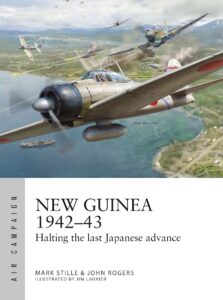Mark Stille & John Rogers, New Guinea 1942-43 (Osprey, 2025)
Many historians highlight turning points that determine how campaigns are won and lost. But some, if not most, campaigns do not fit that model. They are attritional, with their outcomes dependent on resource allocation and a myriad of small victories and setbacks. The air campaign over New Guinea in 1942 seems to fit the latter model. Mark Stille and John Rogers narrate the events of that campaign and analyse its conduct and the reasons for Allied success and Japanese failure.
In early 1942, Japan still has imperial conquest on its mind. Control of Papua New Guinea formed an important part of the imperial strategy. The Allies needed New Guinea to defend Australia. For both of them, distance and environment presented tactical headaches. Stille surveys the respective capabilities of both sides. For the Japanese, both the navy and army air forces would be involved in the fighting. Their main warplane was the famous, or infamous, Zero. The Allies opened with an aerial disadvantage. The Australians in particular had very little to play with, and the US prioritized Europe, reducing their effectiveness in the Pacific. Stille notes that both would improve through 1942. The campaign objectives come next, with a deeper dive into the strategies of both sides. Then we are into the narrative of the campaign.
Even while still consolidating its gains, Japan moved aggressively to reduce Port Moresby in January 1942. The opening engagements favoured the Japanese, with the Zeros dominating the skies. Spurious raiding from both sides turned into a battle of attrition from April. That did not favour the Japanese with more US forces coming on tap. Along the way, Stille connects his narrative to the broader strategic situation; for example, he considers the effects of the Battle of the Coral Sea, the Japanese invasion of Buna, and the Battle of the Bismarck Sea. Ultimately, the Allied superiority in logistics and tactical innovations turned the tide against the Japanese. Stille concludes that the Japanese contributed to their own demise, so much so that their defeat almost appeared inevitable.
New Guinea 1942-43 is an action-packed and informative introduction to the air war in that part of the Pacific theatre during a crucial phase in the war. Stille and Rogers clearly know their stuff, and their text is accompanied by many illuminating maps, photographs, and illustrations. My only criticism is that that the text needed a final edit: the alternative plan of reducing the font to fit all the text into the format did not help this reviewer’s aging eyes. Nevertheless, anyone interested in aerial warfare and the Pacific theatre will undoubtedly enjoy this book.
